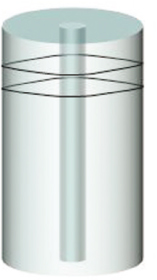J Korean Acad Conserv Dent.
2011 Mar;36(2):125-131. 10.5395/JKACD.2011.36.2.125.
Effect of surface treatment of FRC-Post on bonding strength to resin cements
- Affiliations
-
- 1Department of Conservative Dentistry, Gangneung-Wonju National University College of Dentistry, Gangneung, Korea. drbozon@gwnu.ac.kr
- KMID: 2251817
- DOI: http://doi.org/10.5395/JKACD.2011.36.2.125
Abstract
OBJECTIVES
The purpose of this study was to evaluate the effect of surface treatment of FRC-Post on bonding strength to resin cements.
MATERIALS AND METHODS
Pre-surface treated LuxaPost (DMG), Rely-X Fiber Post (3M ESPE) and self adhesive resin cement Rely-X Unicem (3M ESPE), conventional resin cement Rely-X ARC (3M ESPE), and Rely-X Ceramic Primer (3M ESPE) were used. After completing the surface treatments of the posts, posts and resin cement were placed in clear molds and photo-activation was performed. The specimens were sectioned perpendicular to the FRC-Post into 2 mm-thick segments, and push-out strength were measured. The results of bond strength value were statistically analyzed using independent samples t-test and one-way ANOVA with multiple comparisons using Scheffe's test.
RESULTS
Silanization of posts affect to the bond strength in LuxaPost, and did not affect in Rely-X Fiber Post. Rely-X ARC showed higher value than Rely-X Unicem.
CONCLUSIONS
Silanization is needed to enhance the bond strength between LuxaPost and resin cements.
Keyword
Figure
Cited by 1 articles
Reference
-
1. Aksornmuang J, Foxton RM, Nakajima M, Tagami J. Microtensile bond strength of a dure-cure resin core material to glass and quartz fibre posts. J Dent. 2004. 32:443–450.
Article2. Ferrari M, Goracci C, Sadek FT, Monticelli F, Tay FR. An investigation of the interfacial strengths of methacrylate resin-based glass fiber post-core build-ups. J Adhes Dent. 2006. 8:239–245.3. Monticelli F, Osorio R, Sadek FT, Radovic I, Toledano M, Ferrari M. Surface treatments for improving bond strength to prefabricated fiber posts: a literature review. Oper Dent. 2008. 33:346–355.
Article4. Radovic I, Monticelli F, Goracci C, Cury AH, Coniglio I, Vulicevic ZR, Garcia-Godoy F, Ferrari M. The effect of sandblasting on adhesion of a dual-cured resin composite to methacrylic fiber posts: Microtensile bond strength and SEM evaluation. J Dent. 2007. 35:496–502.
Article5. Monticelli F, Osorio R, Toledano M, Goracci C, Tay FR, Ferrari M. Improving the quality of the quartz fiber postcore bond using sodium ethoxide etching and combined silane/adhesive coupling. J Endod. 2006. 32:447–451.
Article6. Radovic I, Monticelli F, Cury AH, Bertelli E, Vulicevic ZR, Ferrari M. Coupling of composite resin cements to quartz fiber posts: a comparison of industrial and chairside treatments of the post surface. J Adhes Dent. 2008. 10:57–66.7. Perdigão J, Gomes G, Lee IK. The effect of silane on the bond strengths of fiber posts. Dent Mater. 2006. 22:752–758.
Article8. Rathke A, Haj-Omer D, Muche R, Haller B. Effectiveness of bonding fiber posts to root canals and composite core build-ups. Eur J Oral Sci. 2009. 117:604–610.
Article9. Goracci C, Tavares AU, Fabianelli A, Monticelli F, Raffaelli O, Cardoso PC, Tay F, Ferrari M. The adhesion between fiber posts and root canal walls: comparison between microtensile and push-out bond strength measurements. Eur J Oral Sci. 2004. 112:353–361.
Article10. Keum HJ, Yoo HM. Effect of surface treatments of fiber posts on bond strength to composite resin cores. J Korean Acad Conserv Dent. 2010. 35:173–179.
Article11. Kamada K, Taira Y, Yoshida K, Atsuta M. Effect of four silane coupling agents on bonding of two resin-modified glass ionomer cements to a machinable ceramic. Dent Mater J. 2007. 26:240–244.
Article12. Monticelli F, Osorio R, Tay FR, Sadek FT, Ferrari M, Toledano M. Resistance to thermo-mechanical stress of different coupling agents used as intermediate layer in resin-fiber post bonds. Am J Dent. 2007. 20:416–420.13. Erdemir U, Mumcu E, Topcu FT, Yildiz E, Yamanel K, Akyol M. Micro push-out bond strengths of 2 fiber post types luted using different adhesive strategies. Oral Surg Oral Med Oral Pathol Oral Radiol Endod. 2010. 110:534–544.
Article14. Cho MW, Park SH, Kim JR, Choi KK. The bonding durability of resin cements. J Korean Acad Conserv Dent. 2007. 32:343–355.
Article15. Pavan S, dos Santos PH, Berger S, Bedran-Russo AK. The effect of dentin pretreatment on the microtensile bond strength of self-adhesive resin cements. J Prosthet Dent. 2010. 104:258–264.
Article16. Valandro LF, Yoshiga S, de Melo RM, Galhano GA, Mallmann A, Marinho CP, Bottino MA. Microtensile bond strength between a quartz fiber post and a resin cement: effect of post surface conditioning. J Adhes Dent. 2006. 8:105–111.17. Vano M, Goracci C, Monticelli F, Tognini F, Gabriele M, Tay FR, Ferrari M. The adhesion between fibre posts and composite resin cores: the evaluation of microtensile bond strength following various surface chemical treatments to posts. Int Endod J. 2006. 39:31–39.
Article18. Monticelli F, Toledano M, Tay FR, Cury AH, Goracci C, Ferrari M. Post-surface conditioning improves interfacial adhesion in post/core restorations. Dent Mater. 2006. 22:602–609.
Article19. Jongsma LA, Kleverlaan CJ, Feilzer AJ. Influence of surface pretreatment of fiber posts on cement delamination. Dent Mater. 2010. 26:901–907.
Article20. Gerth HU, Dammaschke T, Züchner H, Schäfer E. Chemical analysis and bonding reaction of RelyXUnicem and Bifix composites-a comparative study. Dent Mater. 2006. 22:934–941.
Article21. Habekost Lde V, Camacho GB, Demarco FF, Powers JM. Tensile bond strength and flexural modulus of resin cements-influence on the fracture resistance of teeth restored with ceramic inlays. Oper Dent. 2007. 32:488–495.
Article22. Kim MH, Kim HJ, Cho YG. Effect of curing methods of resin cements on bond strength and adhesive interface of post. J Korean Acad Conserv Dent. 2009. 34:103–112.
Article
- Full Text Links
- Actions
-
Cited
- CITED
-
- Close
- Share
- Similar articles
-
- Retentive bond strength of fiber-reinforced composite posts cemented with different surface treatments
- The effect of bonding resin on bond strength of dual-cure resin cements
- Effect of silane activation on shear bond strength of fiber-reinforced composite post to resin cement
- The effect of repeated bonding on the shear bond strength of different resin cements to enamel and dentin
- THE EFFECT OF SURFACE TREATMENT ON FRACTURE STRENGTH OF DENTAL CERAMICS



